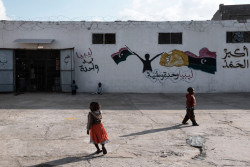 寄付方法のご案内
寄付方法のご案内
 ご寄付による支援例・成果
ご寄付による支援例・成果
 領収書
領収書
 その他のご協力方法
その他のご協力方法
 個人のみなさま
個人のみなさま
 学校・園のみなさま
学校・園のみなさま
 大学生ボランティア
大学生ボランティア
【2019年10月22日 アンマン(ヨルダン)発】
リビアの首都トリポリ周辺で子どもたちが攻撃の犠牲になっていることを受け、ユニセフ(国連児童基金)中東・北アフリカ地域事務所代表のテッド・チャイバンは次の声明を発表しました。
 |
|
© UNICEF/UN052805/Romenzi |
|
拘置施設の外を歩く移民の子どもたち。(2017年1月撮影)※本文との直接の関係はありません |
この2週間、トリポリの子どもたちは暴力によって深刻な被害を受けています。
先週17日、首都トリポリから16キロ離れた幹線道路を走行中の車内にいた3人の子どもと2人の女性が死亡したと伝えられています。10月14日には、首都南部にある民家が攻撃され、3人の姉妹が殺害され、母親ともう一人の娘が重傷を負いました。その前日には、13歳の子どもが自宅にいるときに殺害され、さらに今月初め、首都から18キロ離れたジャンズール(Janzour)で、学校にいた5人の子どもが負傷しました。
これらの直近の攻撃は、リビアの西部のあちこちで暴力行為が続いており、もっとも大きな代償を誰よりも最初に払わされるのは子どもたちであることを、私たちに思い出させます。
子どもたちは標的ではなく、どこにいても常に保護されるべきです。紛争当事者は、民家、学校、病院、医療施設を含む民間インフラへの攻撃を止めなければなりません。
* * *
リビアでは、7年以上も終わらない紛争、政治的混乱、社会サービスの崩壊によって、子ども約25万人を含む、少なくとも82万3,000人が人道支援を切実に必要としています。特に首都トリポリ周辺での戦闘は、人々の生活に大きな打撃を与えています。
【関連ページ】
シェアする
